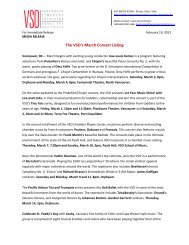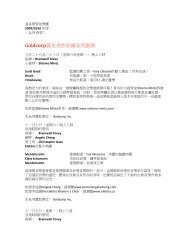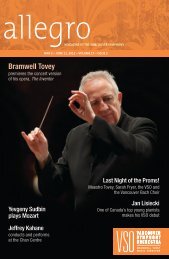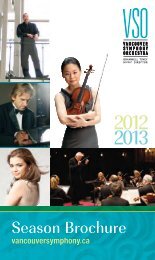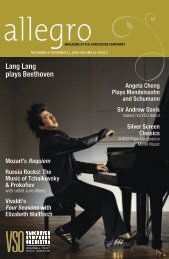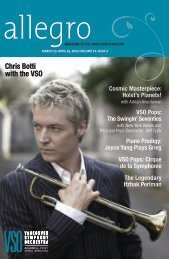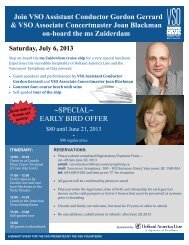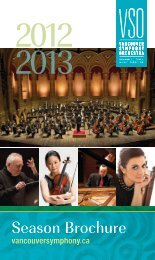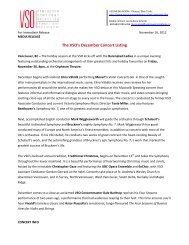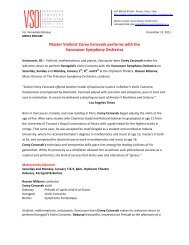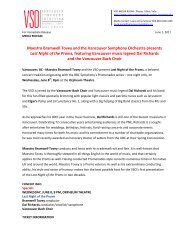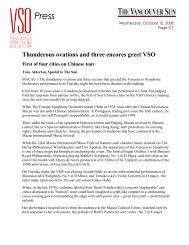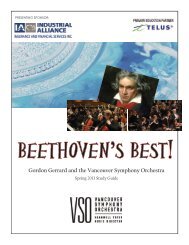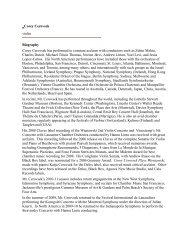VSO Season Finale - Vancouver Symphony Orchestra
VSO Season Finale - Vancouver Symphony Orchestra
VSO Season Finale - Vancouver Symphony Orchestra
Create successful ePaper yourself
Turn your PDF publications into a flip-book with our unique Google optimized e-Paper software.
Johann Sebastian Bachb. Eisenach, Germany / March 21, 1685d. Leipzig, Germany / July 28, 1750Brandenburg Concerto No. 5in D Major, BWV 1050In 1719, Bach’s employer sent him toBerlin, to bring back a harpsichord hehad purchased there. Bach made theacquaintance of Christian Ludwig, Margrave(or ruler) of Brandenburg, a town in Prussia.After revising and polishing six concertos,Bach sent them off to Brandenburg, a lavishdedication attached. That inscription – whichdemonstrates that lengthy, flowery thankyousto wealthy patrons are nothing new– earned them the nickname BrandenburgConcertos. The Margrave showed littleinterest in them. They passed, probablyunplayed, into a library in Berlin following hisdeath. They were published for the first timein 1850, in an edition marking the centenaryof Bach’s birth.Each concerto has a different set of featuredinstruments. No. 5 has three soloists: flute,violin and harpsichord. The graciouslyanimated opening movement is the mostextended (lasting as long as the other twocombined) section in the entire set. The slowmovement offers the featured instrumentsmany splendid opportunities for quiet,expressive playing, the flute in particular. Thesuperb entertainment provided by the finalediverts attention from the impressive intricacyof its structure.Joseph Haydnb. Rohrau, Lower Austria / March 31, 1732d. Vienna, Austria / May 31, 1809<strong>Symphony</strong> No. 94 in G Major (Surprise)Haydn made two trips to England, in 1791-92and 1794-95. For them, he composed 12new symphonies (Nos. 93 through 104), sixfor each season. They have become knownas his “London” Symphonies. During andimmediately after his lifetime, two of themwon unequalled popularity: the Surprise(94) and Military (100) Symphonies. Neithernickname originated with him. In the case ofthe Surprise, the story goes (whether it’s truescarcely matters) that he designed the loud,unanticipated chord in the sixteenth bar of thesecond movement to startle into wakefulnessany audience members who might be dozing.It gets the job done, in the genteel manner ofthe day, and never fails to raise a smile eventoday. The symphony was heard for the firsttime at the Hanover Square concert room inLondon on March 23, 1792.In the opening movement, a restfulintroduction precedes a main Allegro whosebasic good cheer survives an almost stormydevelopment section to emerge once moreinto the sun. Haydn based the variationsthat make up the second movement onone of those artless, nursery-rhyme tunesthat seemed to come to him with no effortwhatsoever. His unending inventivenessensures that he explores every possible facetof it – from pomposity through puckishnessto pathos – with brilliant, self-effacing skill.Although the third movement is labeled a26 allegro



